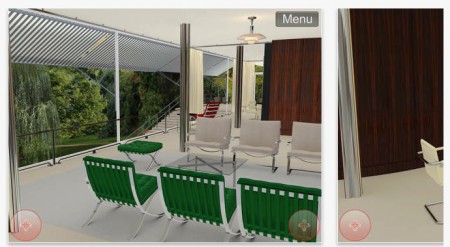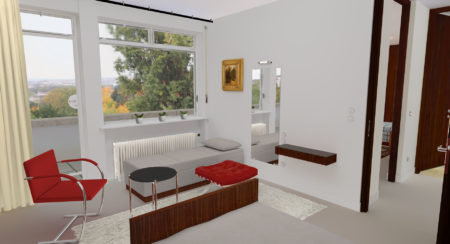The Villa of Greta and Fritz Tugendhat in Brno, Czech Republic, built in 1930, is a pioneering monument to modern European architecture and a designated UNESCO World Cultural Heritage site. Now the freestanding, three-story villa, which is a must-see structure for anyone interested in architectural marvels, can be viewed in real time on desktops and mobile devices via immersive visualizations created by InterMoca, in conjunction with the Museum of the City of Brno.
Digitizing Tugendhat Villa
Over the course of two years, and as time allowed, the digital artists at InterMoca worked to reconstruct the Tugendhat virtual villa using LightWave 3D and a variety of tools, including WTools3D’s LWCAD and the Unity game engine. The goal was to create high-quality models with very small footprints for real-time applications capable of running on 1GB, 2012 smart devices.
The workflow required the team to gather proper source information on-site before modeling, texturing, and pre-lighting of objects in LightWave prior to building the interactivity within the Unity game engine where the shaders, textures, compressions, and so forth are applied.

01 – InterMoca has created a digital version of the new UNESCO World Heritage Site, the Villa Tugendhat, a 1930’s modern architectural icon built for Greta and Fritz Tugendhat in Brno, Czech Republic.
The team also obtained additional resources and size reference information inside the villa; using a Canon 7D and GoPro to capture a large number of reference photographs and video. Photos were also used for textures but the restrictions in the game engine required all the texturing to be simple layers and two UVs, which were exported to Unity using the LightWave FBX Exporter.
“Getting assets into Unity is simply not an issue with the strong FBX interchange tools in LightWave 2015. No hassles, no worries, it just works,” explains Robert Greenyer of InterMoca. “The LightWave UV tools within Modeler also made it easier for the artists; this kind of work requires really well laid out UVs,” he adds.
In LightWave’s Modeler, the artists were able to achieve exact architectural measurements before moving assets to LightWave Layout. And, since Modeler uses real-world scale units, t
he artists were assured that what they built would fit into the virtual environment.
The most important LightWave features for this project, according to Greenyer, were those used to generate the HDRI color maps. LightWave’s Viewport Preview Renderer (VPR) was used extensively by the group to create photo-matching scenes, which included base textures and baked HDRI color lightmaps in GLSL shading mode to match the actual photography.
Designing for mobile platforms was challenging: The artists had to be constantly aware of polygon count, texture size, and rendering challenges of mobile devices as compared to desktop machines. In the future, InterMoca hopes to further immerse viewers with a version for the Oculus Rift or Galaxy Note 4-based headset.
For the mobile versions digital visitors to the Villa Tugendhat can explore the project in 3D with high frame rates for a smooth visual experience. Both the Apple iOS platform and Google’s Android are supported in both free and paid versions. The paid Pro versions and their income help support the Villa Tugendhat and the Pro versions include much more exploration features (more rooms, etc).

03 – A screenshot of the Villa Tugendhat Pro application for iOS (iPad and iPhone). The three dollar app helps support the Villa, a modern icon.
Additionally, the Pro versions allow you to explore the main living spaces in their entirety and also activate the famously massive floor to ceiling glass windows in front of the lounge and dining areas. (see image above). The Villa Tugendhat was the world’s first residential building to be based on a steel structure and is an icon of modern architecture.
The visualization is available at http://intermoca.com/store/
This wishing to learn more about the Villa Tugendhat itself and visit the actual building can go here for more info.
Benefits of LightWave in the Process
Created by artists for artists, LightWave 3D is award-winning software that offers an end-to-end production pipeline for artists and designers to model, animate, capture, retarget, render, and input and output to 3D.
Some of the many new features of LightWave 2015 include advanced Bullet Constraints, Importance Sampling, Match Perspective, the Genoma 2 Character Rigging System, Edge Rendering, and 64-bit support.
LightWave 2015 also includes new enhancements to the Viewport Preview Renderer (VPR) and introduces additional new features and improvements such as Interactive Dynamic Parenting, Textured Falloffs in Modeler, Fiber FX, GoZ multi-tool and Unity 5 support, and more. It also supports the latest interchange formats such as Alembic 1.5 and FBX 2015.
Artists are invited to test drive the software by downloading a free full-feature 30-day trial version of LightWave 2015 at www.lightwave3d.com/try_
Pricing and Availability
LightWave 2015 is now shipping and is priced at $995 USD (full license); $495 USD (upgrade). Educational pricing is also available. For more information about LightWave 3D software or the LightWave 3D Group, please visit www.lightwave3d.com.
To learn more about Newtek visit them online at: www.newtek.com.





Reader Comments
Ludwig Mies van der Rohe’s master work the Villa Tugendhat, a UNESCO World Heritage Site in the Czech Republic city …https://t.co/6pibO4NLGt
Ludwig Mies van der Rohe’s master work the Villa Tugendhat, a UNESCO World Heritage Site in the Czech Republic city …https://t.co/6pibO4NLGt
UNESCO World Cultural Heritage Site Goes Interactive with LightWave 3D and Unity https://t.co/OGadVVdPAz
UNESCO World Cultural Heritage Site Goes Interactive with LightWave 3D and Unity https://t.co/OGadVVdPAz
Czech @UNESCO World Cultural Heritage Site Goes Interactive with LightWave 3D and Unity http://t.co/t5Q3v0r2PI via @architosh
Czech @UNESCO World Cultural Heritage Site Goes Interactive with LightWave 3D and Unity http://t.co/t5Q3v0r2PI via @architosh
Comments are closed.